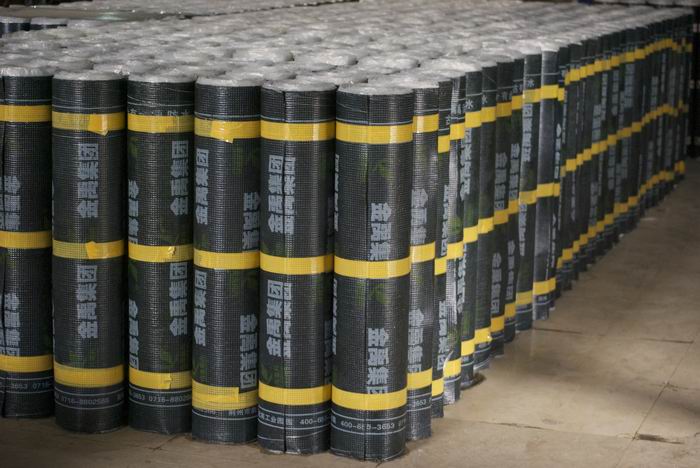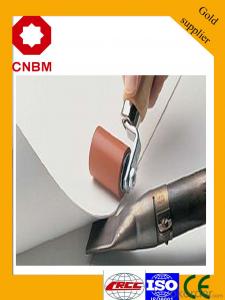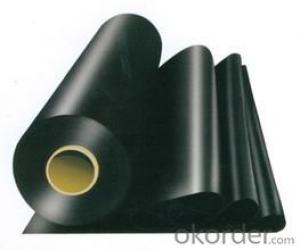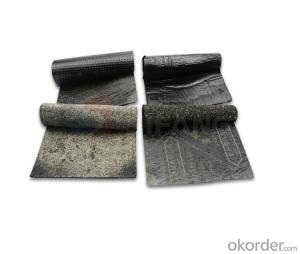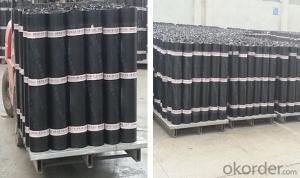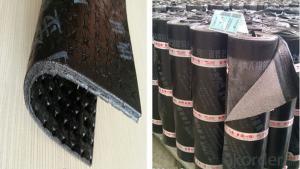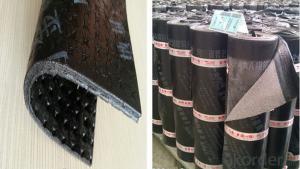SBS modified bitumious waterproof material rolls
OKorder Service Pledge
OKorder Financial Service
You Might Also Like
Where to use:
Roofs or undergrounds
Pools, such as swimming pools, fire pools
Subways, tunnels, concrete road or bridge surfaces
Sewage plants, garbage burying projects
Penstocks
Advantages:
The combination of polyester fiber and SBS modified bitumen is showed good performance on waterproofness
It will be a high-strength membrane to resist water
Puncture-resisting, tear-resisting, corrosion-resisting, mould-resisting and weather-resisting
Good tensile strength and elongation
Strong adaptability for substrate shrinkage, deformation and cracks
Both high and low temperature resistance, especially in cold areas
Convenient to apply: use heat fusion method in all seasons
Packaging: SBS-PYPE material is packed in rolls with plastic bags.
Storage: SBS-PYPE material should be stored in well-ventilated shade place and protected from sun or rain. The temperature in stored places can not be higher than 50° C. It only can be put vertically in single-level. The normal shelf life is 1 year
- Q: Can a waterproofing membrane be used on EPDM roofs?
- EPDM roofs can benefit from the use of a waterproofing membrane. This synthetic rubber roofing material, known as EPDM, is popular for low-slope and flat roofs due to its durability and flexibility. Although EPDM roofs are already waterproof, adding a waterproofing membrane can offer an added layer of defense, increasing the roof's lifespan. By acting as a barrier against water infiltration, the waterproofing membrane prevents leaks and moisture-related harm. Nonetheless, it is crucial to guarantee that the chosen waterproofing membrane is compatible with EPDM and installed according to the manufacturer's instructions to preserve the roof's integrity.
- Q: Can a waterproofing membrane be applied on vertical surfaces?
- Yes, a waterproofing membrane can be applied on vertical surfaces. Waterproofing membranes are designed to create a protective barrier against water penetration, and they can be effectively applied on vertical surfaces such as walls or columns to prevent water damage or leakage.
- Q: Can waterproofing membranes be used on utility vaults?
- Yes, waterproofing membranes can be used on utility vaults. Utility vaults are typically underground structures that house important utility equipment such as electrical transformers, water meters, or communication systems. These vaults are susceptible to water infiltration, which can cause damage to the equipment and compromise its functionality. Waterproofing membranes are a common solution to prevent water from entering utility vaults. These membranes are typically made of durable materials such as rubber, PVC, or modified bitumen, which provide an impermeable barrier against water. They are applied to the walls and floors of the vault, creating a watertight seal that prevents moisture from seeping in. By using waterproofing membranes on utility vaults, the risk of water damage is significantly reduced. This helps to ensure the functionality and longevity of the equipment housed inside. Additionally, waterproofing membranes can also provide protection against other potential issues such as leaks, corrosion, and chemical damage. However, it is important to note that the application of waterproofing membranes on utility vaults requires proper surface preparation and installation techniques to ensure a successful and long-lasting waterproofing system. Therefore, it is recommended to consult with a professional waterproofing contractor who has experience in working with utility vaults to ensure the best results.
- Q: Can a waterproofing membrane be used in renovation or retrofitting projects?
- Yes, a waterproofing membrane can definitely be used in renovation or retrofitting projects. This membrane is designed to create a barrier against water penetration, which is essential in protecting the building structure from moisture damage. By applying a waterproofing membrane during renovation or retrofitting, it helps prevent water infiltration, dampness, mold growth, and potential structural issues.
- Q: What is the recommended temperature range for applying a waterproofing membrane?
- The optimal temperature range for applying a waterproofing membrane varies depending on the specific product. Generally, it is recommended to apply the membrane between 50°F and 90°F (10°C to 32°C). This temperature range ensures that the membrane bonds and cures effectively, resulting in effective waterproofing. Following the manufacturer's instructions is important, as they may provide more specific temperature recommendations based on their formulation and application process. It is also crucial to consider the ambient temperature and conditions during application, as extreme temperatures or weather conditions can impact the membrane's performance and effectiveness.
- Q: Can a waterproofing membrane be used for below-grade parking structures?
- Yes, a waterproofing membrane can be used for below-grade parking structures. Waterproofing membranes are commonly used in construction to prevent the ingress of water and protect structures from water damage. In the case of below-grade parking structures, which are underground or partially underground, there is a higher risk of water infiltration due to the surrounding soil and groundwater. Waterproofing membranes are applied to the exterior surfaces of the structure, creating a barrier that prevents water from seeping through the walls and floors. These membranes are typically made of materials such as bitumen, rubberized asphalt, PVC, or polyurethane, which are highly resistant to water penetration. Additionally, some membranes may also have additional properties like crack-bridging capabilities or protection against chemicals or gases. It is important to consult with a qualified engineer or waterproofing specialist to determine the most suitable membrane for a specific below-grade parking structure, taking into consideration factors such as soil conditions, hydrostatic pressure, and local building codes.
- Q: Can a waterproofing membrane be used for exterior applications?
- Yes, a waterproofing membrane can be used for exterior applications. Waterproofing membranes are specifically designed to protect surfaces from water infiltration and can be used in various exterior applications, such as roofs, balconies, decks, foundations, and below-grade structures. These membranes are typically made from durable materials that can withstand harsh weather conditions, UV exposure, and temperature fluctuations. They provide a protective barrier against moisture, preventing water damage, leaks, and mold growth. Additionally, waterproofing membranes can be applied to different types of surfaces, including concrete, wood, metal, and even existing roofing systems, making them versatile for exterior applications.
- Q: Are waterproofing membranes resistant to thermal expansion?
- Yes, waterproofing membranes are typically resistant to thermal expansion. They are designed to withstand temperature changes without undergoing significant dimensional changes, ensuring their effectiveness in preventing water penetration and maintaining their integrity.
- Q: Can a waterproofing membrane be used for solar panel installations?
- Indeed, the utilization of a waterproofing membrane in solar panel installations is not only possible but highly recommended. It is common practice to incorporate a waterproofing membrane into the installation process in order to safeguard the roof or other surfaces beneath the solar panels from water-related harm. The primary function of a waterproofing membrane is to serve as a barrier, preventing water infiltration into the underlying structure. This, in turn, ensures the integrity and security of the solar panel installation, which is of utmost significance considering their typical placement on rooftops, where they are exposed to various weather conditions. By incorporating a waterproofing membrane, the longevity of the solar panels is prolonged, and any potential issues arising from water are effectively mitigated, thus preserving their optimal performance.
- Q: Can a waterproofing membrane be used for water treatment plants?
- Yes, a waterproofing membrane can be used for water treatment plants. It can provide an effective barrier to prevent water leakage and protect the structure from moisture damage. Additionally, waterproofing membranes can help maintain the quality and integrity of the treated water by preventing contamination from external sources.
Send your message to us
SBS modified bitumious waterproof material rolls
OKorder Service Pledge
OKorder Financial Service
Similar products
Hot products
Hot Searches
Related keywords



